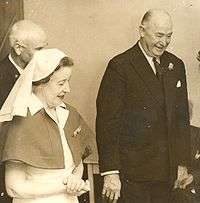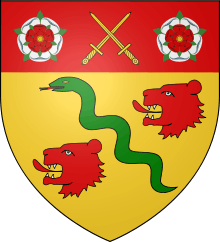Arthur Porritt, Baron Porritt
| Colonel The Right Honourable The Lord Porritt GCMG GCVO CBE FRCS | |
|---|---|
 Arthur Porritt in 1923 | |
| 11th Governor-General of New Zealand | |
|
In office 1 December 1967 – 7 September 1972 | |
| Monarch | Elizabeth II |
| Preceded by | Sir Bernard Fergusson |
| Succeeded by | Sir Denis Blundell |
| 2nd Chairman of the British Empire and Commonwealth Games Federation | |
|
In office 1950–1966 | |
| Preceded by | Sir James Leigh-Wood |
| Succeeded by | Sir Alexander Ross |
| Personal details | |
| Born |
10 August 1900 Wanganui, Manawatu-Wanganui, New Zealand |
| Died |
1 January 1994 (aged 93) London, UK |
| Nationality | New Zealand |
| Profession | Surgeon |
| Military career | |
| Allegiance |
|
| Service/branch |
|
| Years of service | 1940–1956 |
| Rank | Colonel |
| Battles/wars |
*North African Campaign Battle of France Operation Overlord |
| Awards |
Officer of the Order of the British Empire Officer of the Legion of Merit |
Colonel Arthur Espie Porritt, Baron Porritt GCMG GCVO CBE FRCS[1] (10 August 1900 – 1 January 1994) was a New Zealand physician, military surgeon, statesman and athlete. He won a bronze medal at the 1924 Summer Olympics in the 100 m sprint. He served as the 11th Governor-General of New Zealand between 1967 and 1972.
Early life
Porritt was born in Wanganui, New Zealand, the son of Ivy Elizabeth Porritt née McKenzie and Ernest Edward Porritt, a doctor. His mother died in 1914 during his first year at the Wanganui Collegiate School, and his father left soon after to serve in World War I. He became a keen athlete. In 1920 he began studying towards a medical degree at the University of Otago where he was a resident at Selwyn College and President of the Selwyn College Students' Association. In 1923 Porritt was awarded a Rhodes Scholarship, and he studied medicine from 1924 to 1926 at Magdalen College, Oxford.[2]
Sporting career
| Personal information | ||||||||||||||||||||||
|---|---|---|---|---|---|---|---|---|---|---|---|---|---|---|---|---|---|---|---|---|---|---|
| Height | 171 cm (5 ft 7 in) | |||||||||||||||||||||
| Weight | 64 kg (141 lb) | |||||||||||||||||||||
| Sport | ||||||||||||||||||||||
| Sport | Athletics | |||||||||||||||||||||
| Event(s) | Sprint | |||||||||||||||||||||
| Achievements and titles | ||||||||||||||||||||||
| Personal best(s) |
100 yd – 9.8 (1923) 200 m – 21.5 (1925)[3][4] | |||||||||||||||||||||
Medal record
| ||||||||||||||||||||||
He represented New Zealand at the 1924 Summer Olympics in Paris, France, winning a bronze medal in the 100 metre dash;[3] the winner was Harold Abrahams (1899–1978). The race took place at 7 pm on 7 July 1924. Abrahams and Porritt dined together at 7 pm on 7 July every year thereafter, until Abrahams' death. The race was later immortalised in the film Chariots of Fire, but due to Porritt’s modesty his name was changed to "Tom Watson".[5] He also won two qualifying races in the 200 m, but did not advance in the semi-final. Porritt was captain of the New Zealand team at the 1928 Summer Olympics in Amsterdam, but withdrew from the 100 m because of an injury.[3]
Porritt is only one of two people to have the rare honour of twice being the New Zealand flag bearer at Olympic Games, the other being Les Mills.[6]
After retirement from athletics Porritt was New Zealand's team manager at the 1934 British Empire Games in London and 1936 Summer Olympics in Berlin.[3] Porritt was the New Zealand member of the International Olympic Committee from 1934 to 1967. He was the first President of the IOC Medical Commission and served from 1961 to 1967.
He served as chairman of the British Empire and Commonwealth Games Federation from the 1950 Auckland games to the 1966 Kingston games.[7]
Medical and military career
He became a house surgeon at St Mary's Hospital, London, in 1926 and later that year was appointed surgeon to the Prince of Wales, the future King Edward VIII.
On 8 March 1940, Porritt was commissioned a lieutenant in the Royal Army Medical Corps with the service number 125494.[1] He served in France until the evacuation from Dunkirk, then in Egypt, operating on seriously wounded soldiers from the North African campaign, and later landing in Normandy on D-Day. A war-substantive major by February 1943, he was granted the temporary rank of lieutenant-colonel and the acting rank of colonel later that year; on 18 December 1943, he was appointed a consultant surgeon with the local rank of brigadier, equivalent to a one-star general officer.[8][9] He relinquished this position and his brigadier's rank on 1 September 1945, by which time he was a war-substantive lieutenant-colonel.[10] He ended his military career in September 1956, with the honorary rank of colonel in the Territorial Army.[11]
He was King's Surgeon to George VI from 1946 to 1952, and was Serjeant Surgeon to Queen Elizabeth II until 1967.[5]
In 1955 he was called to Eastbourne by the suspected serial killer John Bodkin Adams, to operate on his patient Jack Hullett for colon cancer. The operation was a moderate success but the death of Hullett under Adams' supervision a few months later followed soon after by the death of his wife Bobby, led to Adams being put on trial for Bobby's murder in 1957. He was acquitted but is suspected in up to 163 deaths.[12]
Porritt was twice president of the Hunterian Society (once in 1951) and became president in 1960 of both the British Medical Association and the Royal College of Surgeons of England, the first person to hold the two positions simultaneously, and retained the presidency of the RCS until 1963.[5]
In 1966 he was elected president for two years of the Royal Society of Medicine but served only one year before leaving for New Zealand.
Honours
Porritt was appointed an Officer of the Order of the British Empire (OBE) in 1943,[8] and promoted to Commander (CBE) in 1945.[13] He was decorated as an Officer of the US Legion of Merit on 14 November 1947.[14] He was appointed a Knight Commander of the Order of Saint Michael and Saint George (KCMG) in 1950,[15] and was promoted to Knight Grand Cross (GCMG) in 1967. in 1957 he was appointed a Knight Commander of the Royal Victorian Order (KCVO),[16] being promoted to Knight Grand Cross (GCVO) in 1970.[17] He was also made a Knight of the Order of St John of Jerusalem (KStJ) in 1957.[18]
Sir Arthur was created a Baronet 'of Hampstead' on 25 January 1963.[5][19] When he was elevated to be a Life Peer on 5 February 1973, he chose to honour his home town and was created Baron Porritt, of Wanganui in New Zealand and of Hampstead in Greater London.[20]
Governor-General

In 1967 Porritt returned to New Zealand to be appointed by the Queen on the advice of Prime Minister Keith Holyoake as the 11th Governor-General of New Zealand, and the first born in New Zealand.[5] His term marked a turning-point in the country's constitutional history: his successors have all been New Zealanders (although one of his predecessors, Lord Freyberg, moved to New Zealand when he was two).
Controversies
Prior to the 1969 general election in September of that year, Porritt sparked a heated debate with a Labour candidate Eddie Isbey when he argued in a speech to the Southern Cross Medical Care Society that the welfare state was "uneconomic".[21]
Later, Porritt's wife also created controversy, when she replied to a question on equal pay for women by stating "Perhaps when New Zealand, like India and Israel, produces a woman prime minister it will be time to call a halt to the emancipation movement".[21]
At his last Waitangi Day speech in 1972, Porritt caused more controversy by stating that: "Maori-Pakeha relationships are being dealt with adequately through the biological process of intermarriage".[21]
At the end of his term in September 1972 Porritt returned to England.
Memorials
In Christchurch, New Zealand, a park was aptly named Porritt Park in the suburb of Wainoni. The park surrounded by the Avon River became home to Canterbury Hockey, Canterbury Rowing, Canterbury Touch Rugby and also used as a venue for Cricket. PORRITT Primary School in Napier opened in 1975, named in honour of his service to New Zealand. He has also a dedication of a running track in the Waikato, New Zealand named Porritt Stadium.
Freemasonry
He was a freemason. During his term as Governor-General (1968–1971), he was also Grand Master of the Grand Lodge of New Zealand.[22]
Death
Lord Porritt died in London at the age of 93 on 1 January 1994.[3] His wife died in 1998. His son is Jonathon Porritt, a well-known environmental activist.
Arms
 |
|
References
- 1 2 "No. 34830". The London Gazette (Supplement). 12 April 1940. p. 2229.
- ↑ Beaglehole, Diana. "Porritt, Arthur Espie". Dictionary of New Zealand Biography. Ministry for Culture and Heritage. Retrieved 17 June 2017.
- 1 2 3 4 5 "Arthur Porritt Olympic Results". sports-reference.com. Retrieved 15 October 2012.
- ↑ Arthur Porritt. trackfield.brinkster.net
- 1 2 3 4 5 Brett & Kate McKay (6 July 2010). "The Whole Man: 25 Men Who Cultivated Both Mind and Body". ArtofManliness.com. The Art of Manliness. Archived from the original on 9 July 2010. Retrieved 7 July 2010.
- ↑ "Mark Todd best bet to carry NZ's flag again". stuff.co.nz. Retrieved 22 April 2012.
- ↑ "The Story of The Commonwealth Games". Commonwealth Games Federation. Retrieved 26 June 2012.
- 1 2 "No. 35908". The London Gazette (Supplement). 18 February 1943. p. 859.
- ↑ "No. 36343". The London Gazette (Supplement). 18 February 1943. p. 461.
- ↑ "No. 37660". The London Gazette (Supplement). 19 July 1946. p. 3789.
- ↑ "No. 40888". The London Gazette (Supplement). 25 September 1956. p. 5483.
- ↑ Cullen, Pamela V., "A Stranger in Blood: The Case Files on Dr John Bodkin Adams", London, Elliott & Thompson, 2006, ISBN 1-904027-19-9
- ↑ "No. 36917". The London Gazette (Supplement). 1 February 1945. p. 670.
- ↑ "No. 38122". The London Gazette (Supplement). 11 November 1947. p. 5352.
- ↑ "No. 38929". The London Gazette (Supplement). 8 June 1950. p. 2778.
- ↑ "No. 40960". The London Gazette (Supplement). 1 January 1957. p. 5.
- ↑ "No. 45110". The London Gazette. 29 May 1970. p. 6039.
- ↑ "No. 40972". The London Gazette. 8 January 1957. p. 229.
- ↑ "No. 42907". The London Gazette. 29 January 1963. p. 909.
- ↑ "No. 45901". The London Gazette. 8 February 1973. p. 1797.
- 1 2 3 Gavin Mclean (October 2006), The Governors, New Zealand Governors and Governors-General, Otago University Press, p. 281
- ↑ VICE REGAL GRAND MASTERS – WHO AND WHY? kenthenderson.com.au
External links
| Wikimedia Commons has media related to Arthur Porritt, Baron Porritt. |
- Biography in Plarr's Lives of the Fellows Online
- Biography at New Zealand Olympic Committee website
- "Arthur Porritt – No Ordinary Man" (biography by Graeme Woodfield)
| Government offices | ||
|---|---|---|
| Preceded by Sir Bernard Fergusson |
Governor-General of New Zealand 1967–1972 |
Succeeded by Sir Denis Blundell |
| Professional and academic associations | ||
| Preceded by |
President of the British Medical Association 1960–1961 |
Succeeded by Sir George Douglas Robb |
| Preceded by Sir James Ross |
President of the Royal College of Surgeons of England 1960–1963 |
Succeeded by Sir Russell Brock |
| Preceded by Lord Cohen of Birkenhead |
President of the Royal Society of Medicine 1966–1967 |
Succeeded by Sir Hector MacLennan |
| Baronetage of the United Kingdom | ||
| New creation | Baronet (of Hampstead) |
Succeeded by unproven incumbent (Jonathon Porritt) |
